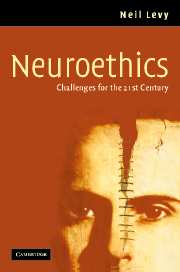Book contents
- Frontmatter
- Contents
- Preface
- Acknowledgements
- 1 Introduction
- 2 Changing our minds
- 3 The presumption against direct manipulation
- 4 Reading minds/controlling minds
- 5 The neuroethics of memory
- 6 The “self” of self-control
- 7 The neuroscience of free will
- 8 Self-deception: the normal and the pathological
- 9 The neuroscience of ethics
- References
- Index
4 - Reading minds/controlling minds
Published online by Cambridge University Press: 16 December 2010
- Frontmatter
- Contents
- Preface
- Acknowledgements
- 1 Introduction
- 2 Changing our minds
- 3 The presumption against direct manipulation
- 4 Reading minds/controlling minds
- 5 The neuroethics of memory
- 6 The “self” of self-control
- 7 The neuroscience of free will
- 8 Self-deception: the normal and the pathological
- 9 The neuroscience of ethics
- References
- Index
Summary
Much of the interest and anxiety provoked by new and developing neuroscientific technologies is centered around two issues: the extent to which these technologies might allow their users to read the thoughts of people, and (as if that prospect was not disturbing enough) the extent to which these technologies might actually be used to control people. Some commentators believe that one or both of these issues are pressing, in the sense that the relevant technologies will soon be available; some even believe that these technologies already exist. In this chapter, we will ask how worried we should be. Are these technologies imminent? And if they are, are they as threatening as they appear?
MIND READING AND MIND CONTROLLING
There has been a great deal of interest in the possibility of “brain reading” as a lie detection technology. The problems with existing lie detectors are well known: they produce high rates both of false positives and of false negatives, and they can be “beaten” by people who deliberately heighten their responses to control questions, which are used to establish a baseline for comparison. In its overview of current lie-detection techniques, the US National Research Council concluded that there is “little basis for the expectation that a polygraph test could have extremely high accuracy” (National Research Council 2003: 212). The reasons for this conclusion are many: because the responses measured are not uniquely involved in deception, because they include responses that can be deliberately controlled and because the technology is difficult to implement in the real-world.
- Type
- Chapter
- Information
- NeuroethicsChallenges for the 21st Century, pp. 133 - 156Publisher: Cambridge University PressPrint publication year: 2007



